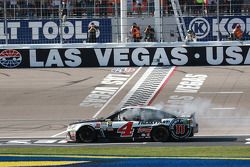Five takeaways from Las Vegas-New Hampshire race move
Speedway Motorsports Inc.’s decision to move one of its Monster Energy NASCAR Cup Series races from New Hampshire Motor Speedway to Las Vegas in 2018 appeared to some to come out of nowhere.

Photo by: Action Sports Photography






But did it really?
Here are five things we’ve learned from SMI’s decision:
1. Despite the Wall Street Journal’s proclamations to the contrary, NASCAR races are still viable and financially worthwhile assets to be acquired. The decision by SMI to move one of its Cup dates from one track to another has a potential of risk, but how much of that risk was outweighed by the fact Las Vegas was willing to put up money to help obtain and promote the second race date? In fact, I’m not sure I can site a single other example of a similar effort made by a city since I began covering the sport in 1998. This is not chump change we’re talking about, either.
Las Vegas Convention and Visitors Authority approved a seven-year sponsorship and marketing agreement that would dedicate $1 million per race, plus $500,000 a year to market both the spring and fall events, beginning Jan. 1. The contract carries an option for three additional years. No city, or its regional tourism board, is going to devote hard-to-come-by funds to an effort they don’t believe will benefit the region, especially in this day and age.
2. SMI and its counterpart, International Speedway Corp., don’t answer to race fans, they answer to their shareholders. As much as it would be a wonderful thing if every decision in NASCAR was made only with the fan in mind (or the fan sitting in front of their TV), both SMI and ISC are public companies and answerable to their respective stockholders. True, they don’t exist if there is not a NASCAR, but they also don’t exist if they don’t give their stockholders a return on their investments.
NASCAR race tracks are large, money-eating properties that are rarely filled to capacity more than once or twice a year, depending on the venue. Yet, they have to remain viable and maintained 365 days a year. SMI and ISC need properties that are located in areas where customers can be found all year and are capable of hosting events that can help fill up the yearly calendar outside of the Cup, Xfinity and Truck series dates.
3. Yes, it’s about the money. It’s always about money. Again, in a perfect world, it would be wonderful to hold to past traditions, but the reality is all of the professional sports that drive the enthusiasm of millions of fans each year require money – and lots of it – to remain viable. As a longtime resident of Charlotte, N.C., I saw the city’s original NBA franchise arrive and then leave when a new arena deal could not be completed that would have allowed the team to bring in more money from luxury suites (where the big money is made, by the way). When did Charlotte get an NBA team back? When it had an updated arena capable of catering to a more lucrative clientele. The San Francisco 49ers, Washington Redskins and numerous other NFL teams don’t play in the same stadiums in which they were founded. Why? More money was needed for stadium upgrades to attract even more fans to spend even more money.
4. There are no more “sacred cows.” The days of thinking this race date or that race date is “guaranteed” simply because of tradition or its longtime location are over. The message has been delivered in bits and spurts over the years with changes from smaller market races to larger ones. But with the long-term viability needing to be addressed of companies like SMI and ISC, I suspect anything is possible. In fact, as much as fans clamor about loving short tracks, Bristol, Tenn., and Richmond, Va., have been two tracks that have seen enormous loss of at-track attendance over the years, for either one or both of their events. At one time, I would have thought a loss of a race date at either location – or even Charlotte for that matter – would be unheard of. No longer.
5. While many of the items in Nos. 1-4 are related to tracks and the companies that own them, that doesn’t leave NASCAR off the hook. Its core responsibility – to deliver a product on the track that is compelling to TV viewers and at-track attendees – remains the same and is more important than ever. You hear a lot of people questioning lately whether there has been “too much change” in the sport of late. But I would much rather see changes on a continual basis that address the quality of racing than none at all. Sitting still will never get you any closer to where you are trying to go.
Be part of Motorsport community
Join the conversationShare Or Save This Story
Subscribe and access Motorsport.com with your ad-blocker.
From Formula 1 to MotoGP we report straight from the paddock because we love our sport, just like you. In order to keep delivering our expert journalism, our website uses advertising. Still, we want to give you the opportunity to enjoy an ad-free and tracker-free website and to continue using your adblocker.















Top Comments